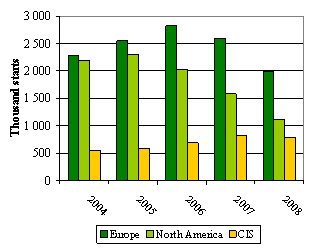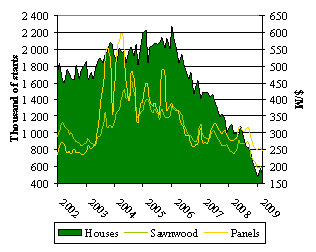UNECE/FAO Forest Products Annual Market Review, 2008-2009:
Forest products markets badly hit by the crisis but use of
wood energy on the rise
Geneva, 4 August 2009 --
The current economic crisis is hitting hard the forest products sector across the UNECE region, according to the UNECE/FAO’s Forest Products Annual Market Review 2008-2009.
Approximately 42% of the global forests are in the UNECE region. The 56-country UNECE region is the world’s largest producer (60% worldwide), consumer (57%), exporter (77%) and importer (70%) of wood and paper products (imports and exports include within-region trade).
From record levels of forest products consumption, production and trade in 2006, the slight downturn for the region in 2007 escalated rapidly in 2008 and continued in the first half of 2009.
Total consumption of forest products in the UNECE region fell by 8.5% overall in 2008, the sharpest year-on-year decline since the first oil shock of 1973, but with marked differences between the three subregions: consumption fell by 12.7% in North-America and 5.9% in Europe but grew by 3.2% in the CIS (see graph 1). Linked directly with demand, production fell accordingly, resulting in mill closures and job losses.
This trend was mainly driven by the sharp decline in the construction of new houses in North-America and Europe. Housing construction is the main driver of forest products markets, especially for the main forest product: sawn softwood (lumber). From a peak of 2.2 million houses in 2006, housing starts in the US fell by 25% in 2007, 34% in 2008 and are expected to fall a further 50% in 2009 (APA – The Engineered Wood Association, May 2009 forecast). In Europe housing construction was down by 13.9% in 2008 and a similar decline is forecast for 2009 (Euroconstruct, January 2009 forecast) (see graph 2).
By contrast, in the CIS, the construction of new houses rose again in 2008, but at a pace only half that of the 10% average growth from 2001-2007. Timber-framed housing in the Russian Federation is growing rapidly and has tripled in the last 10 years, albeit from a low level.
The fall in demand has pushed real prices of building materials to their lowest levels since the 1940s (see graph 3). The paper industry continued deeper into crisis: production in Europe and North America decreased some 17% in 2008 (see graph 4). In the CIS the decline has been smaller thus far but Russia’s negative trade balance in paper products continued to escalate (imports of higher quality and more expensive paper exceed the value of exports of lower value paper such as newsprint).
The wood and paper industries across the region have rationalized production in line with reduced demand: many mills have been permanently shut down. Forest landowners and managers have reduced harvests accordingly, and have sought alternative markets. This means less employment, less income and less tax revenues from forests throughout the UNECE region.
The surge in wood energy markets
The wood energy sector seems to have been immune to the global economic crisis. Demand for renewable energy sources, including wood biomass, continues to grow steadily due to Governments’ incentive policies fostering climate change mitigation efforts and energy security.
World wood fuel pellet markets grew by approximately 20% in 2008 and are expected to double by 2012 (see graph 5). Production capacity has increased faster than consumption, anticipating strong growth in demand.
Europe is the largest consumer and producer of wood fuel pellets, while Canada is the single largest exporter (mainly to Europe). Asia could also become an important consumer of wood fuel pellets, as the first large-scale industrial projects to co-fire coal with wood biomass took place in Japan in 2008.
The forest sector has high expectations that the Copenhagen Climate Change Conference (COP 15) in December 2009 will finalise the international framework to pay for Reducing Emissions from Deforestation and Degradation (REDD), tentatively agreed upon in Bali in December 2007 (COP 13).
In the UNECE region, wood constitutes a secure, sustainable source of renewable energy. In addition, using wood as an energy source will help countries meet their carbon emission reduction targets since the CO2 released when burning wood comes from trees’ uptake of carbon during their life and emissions from burning will be captured in new growing trees. Wood can also be a substitute for non-renewable construction materials like plastics, steel or concrete.
Other key issues for the sector in the COP 15 negotiations are: adopting measures to prevent deforestation and degradation, expanding the role of carbon offset projects, and including carbon accounting to fully include the harvested wood products as carbon storage.
The role of China
China’s forest products output continued rising strongly in 2008 (+23%) driven by economic growth and a multi-billion dollar investment plan in the forest sector launched by the Government as part of a package to stimulate domestic demand (see graph 6 & 7).
While most of China’s production of wood and paper is consumed locally, China is also a major exporter of wood products. The sector registered a trade surplus of $8.7 billion in 2008, but export volumes were down 14.2% due to the global economic slowdown and the fall of imports from the US (see graph 8).
In particular, China has become the world’s largest exporter of furniture (importing wooden raw material and exporting final products). More than half of its furniture exports go to the US market.
For further information please contact:
Ed Pepke
Forest Products Marketing Specialist
UNECE/FAO Timber Section
Trade and Timber Division
United Nations Economic Commission for Europe
Palais des Nations
CH - 1211 Geneva 10, Switzerland
Phone: +41 (0)22 917 2872
Fax: +41 (0)22 917 0041
E-mail: [email protected]
Website: http://www.unece.org/timber/
Note to Editors
The United Nations Economic Commission for Europe (UNECE) Timber Committee and the Food and Agriculture Organization (FAO) European Forestry Commission have been releasing their Forest Products Annual Market Review since the 1950s. These 2 bodies were set up after WWII in order to assist in the restructuring of Europe, and they quickly began collecting, analyzing and disseminating information on the entire forest sector across the UNECE region (CIS, Europe and North America).
The Review covers forest products markets (sawn softwood, sawn hardwood, wood-based panels, paper, paperboard and woodpulp, wood raw materials and tropical timber) and policy developments in the UNECE member States, as well as their major trading partner, China. It also analyses key developments in wood energy, forest products certification, as well as value-added wood products, e.g. furniture. For the first time the Review includes a chapter on the forest sector carbon markets.
The Review provides analyses and data for UNECE’s three subregions: North-America Europe and the Commonwealth of Independent States (CIS).
The Review's statistical database is available currently at http://www.unece.org/timber/
Certified forest products carry labels demonstrating, in a manner verifiable by independent bodies, that they come from forests that meet standards for sustainable forest management. Consumers may find labels on furniture and wood products, while manufacturers can verify the sources through the certification scheme’s chain-of-custody procedures.
Engineered wood products include a range of derivative wood products which are manufactured by binding together the strands, particles, fibers, or veneers of wood, together with adhesives, to form composite materials. These products are engineered to precise design specifications which are tested to meet national or international standards. Typically, engineered wood products are made from the same hardwoods and softwoods used to manufacture sawnwood. Engineered wood products are used in a variety of ways, often in applications similar to solid wood products, such as in construction. Engineered wood products may be preferred over solid wood in some applications due to certain comparative advantages such as strength and specific dimensions at the end use.
Wood fuel pellets are a type of wood fuel, generally made from compacted sawdust. They are usually produced as a by-product of sawmilling and other wood processing activities, including harvesting. The pellets are extremely dense and can be produced with a low humidity content (below 10%) that allows them to be burned with high combustion efficiency. Further, their regular geometry and small size allow automatic feeding with very fine calibration. They can be fed to a burner by auger feeding or by pneumatic conveying.
Graph 1 : Consumption of forest products in the UNECE region,
2004-2008 |
Graph 2: Housing starts in the UNECE region, 2004-2008 |

Note: Based on roundwood equivalent for sawnwood, panels and paper and paperboard.
Source: UNECE/FAO TIMBER database, 2009. |

Notes: For European countries outside Euroconstruct’s 19 country region and CIS, 2008 is a forecast. Europe: Euroconstruct 19 countries plus Bulgaria, Croatia, Estonia, Latvia, Lithuania, Romania, Serbia, Slovenia and Turkey. North America: Canada and the US. CIS: Russia and Ukraine.
Sources: US Census Bureau, Canada Mortgage and Housing Corporation, Euroconstruct, Rosstat, 2009. |
Graph 3:
US housing starts vs. sawnwood and panel prices,
2002-2009 |
Graph 4: Consumption of paper and paperboard in the UNECE region, 2004-2008 |

Notes: Sawnwood is framing lumber composite ($/MBF) and panels are structural panel composite ($/MSF). Averages of 14 product and species composite prices. Houses are single-family and multi-family.
Sources: Random Lengths for prices and National Association of Home Builders for housing starts, 2009. |

Source: UNECE/FAO TIMBER database, 2009. |
Graph 5: Global production of wood fuel pellets, 2000-2010 |
Graph 6: Chinese forest products output, 2002-2008 |

Note: f = forecast.
Sources: Hillring et al., 2007; Hillring et al., 2008. |

Note: Includes roundwood, sawnwood, panels, paper and pulp.
Source: International WOOD Markets Group, 2009. |
Graph 7: Chinese forest products production, 2002-2008 |
Graph 8: Chinese forest product exports, 2002-2008 |

Sources: China Paper Association, International WOOD Markets Global, secretariat estimates, 2009. |

Source: China Customs, 2009. |
Ref: ECE/TIM/09/P04